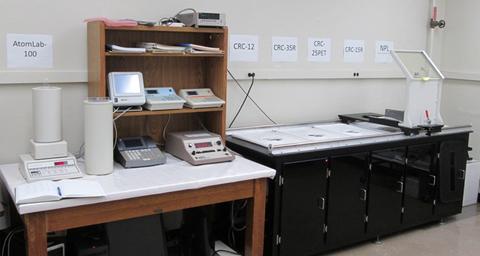Summary
NIST maintains a collection of dose calibrators and develops and reports on secondary activity standards for imaging and therapeutic nuclides.
Description

Some of the NIST-maintained radionuclide calibrators.
In nuclear medicine, clinical activity measurements are typically made using commercially available radionuclide calibrators (also referred to as “dose calibrators”) which incorporate a reentrant 4π ionization chamber and an electrometer. The current measured by these calibrators is translated into activity units by applying a "dial setting" (calibration setting) specific to the nuclide under investigation. Specific manufacturer-recommended dial settings are often determined theoretically by extrapolating from a response curve based on limited experimental data. In addition, they are often determined for a geometry (5 mL ampoule) not often employed in clinical settings. The Radioactivity Group at NIST maintains a collection of commercial radionuclide calibrators, including models from each of the major U.S. manufacturers. Using these instruments, NIST links dial settings for a given nuclide in a given geometry to National standards for activity.
The NIST instruments are subjected to regular quality control measurements, tracking short- and long-term performance. In a few cases, the control-chart based program has identified significant declines (> 1 %) in chamber response over periods of years, resulting in the chambers' removal from service.
Using instruments with demonstrable stability over time (years and decades), NIST maintains reliable secondary activity standards for many radionuclides. For short-lived nuclides, like those typically employed in nuclear medicine, ionization chambers can act as a repository for standards, allowing new standardizations to be compared with old ones without an artefact source for comparison. The radionuclide calibrators hold standards for more than 20 radionuclides, in many cases including calibration settings for several source geometries.
NIST scientists also help guide documentary standards for the use of radionuclide calibrators, participating in American Association of Physicists in Medicine (AAPM), Society of Nuclear Medicine and Molecular Imaging (SNMMI), and International Electrotechnical Commission (IEC) committees.

